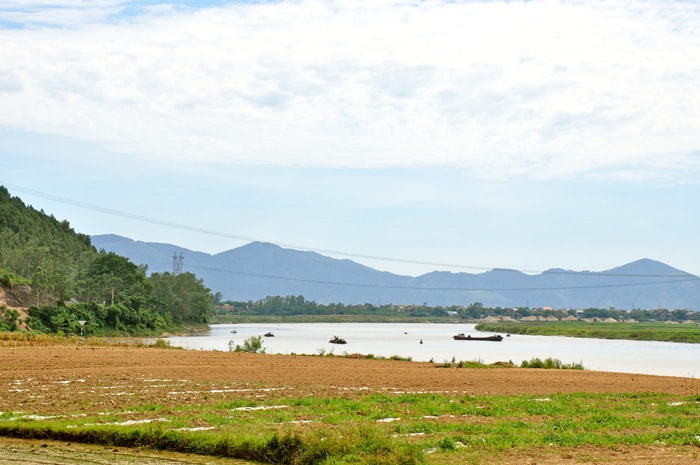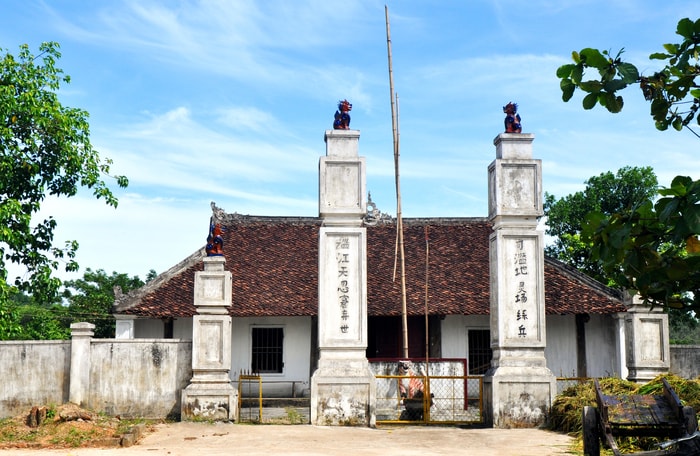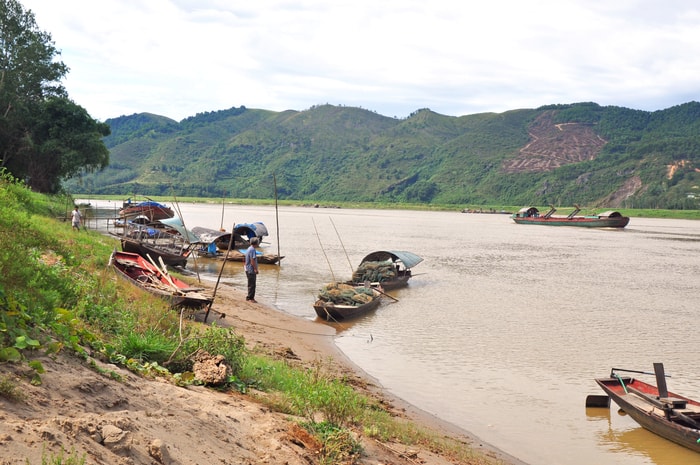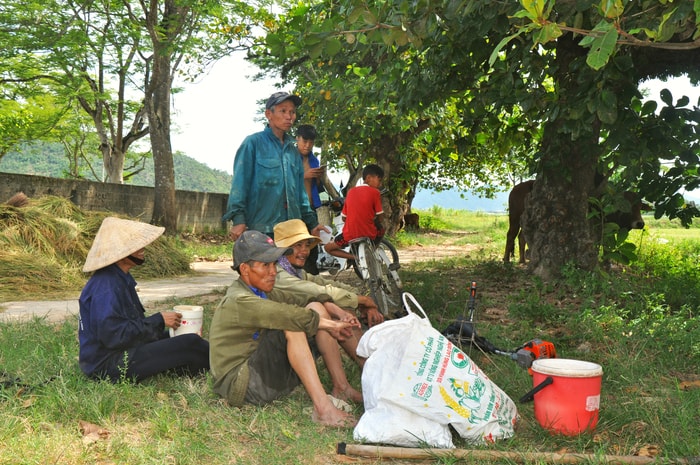Kha Lam - a village tradition
(Baonghean) - Seen from above, Kha Lam village, Nam Thuong commune (Nam Dan) leans against a bow-shaped mountain range, with the Lam river in front as a bowstring. The scenery is imbued with the pristine features of the midland countryside, and the village's name also evokes an ancient...
Kha Lam is truly attractive. The pine ranges stretching to the mountains, the green fields, the undulating corn fields, the herds of buffalo and cows leisurely grazing, and the flowing Lam River paint a picture of a truly prosperous and peaceful countryside. Social life has changed a lot. The district center, about 3-4 km from the village, is bustling and noisy, houses are built close together, but Kha Lam still maintains the same village life.
On the fields and corn fields, simple farmers are working hard to take care of their crops, placing their hopes on the day of harvest, when all their hard work and fatigue will be rewarded with a bountiful harvest, with ripe rice and plump corn cobs.
 |
| Lam River flows through Kha Lam village, Nam Thuong commune (Nam Dan). Photo: Cong Khang |
The asphalt road leads straight into the village, stopping in front of the ancient communal house, in front of the gate are two ancient banyan trees and a vast lotus pond. The communal house bears the name of the village - Kha Lam communal house, built according to Nguyen Dynasty architecture, is the place to worship King Mai Hac De and his generals. The communal house stands majestically in the middle of the village, is a provincial historical - cultural relic, the structures are skillfully and delicately carved, rich in aesthetics, showing the sacredness, and has been carefully preserved by the people for generations.
Inside the communal house, there is a Buddha altar. Kha Lam villagers said that in the past, there was a complex of spiritual architectural works here including a communal house, temples, pagodas, and shrines. Historical changes, especially two long wars, erased everything, leaving only this communal house. When renovating and upgrading the communal house, the villagers decided to bring the Buddha altar back to the temple, meeting spiritual needs and restoring a cultural identity of the village.
The ancient beauty of Kha Lam communal house is also enhanced by two ancient banyan trees whose canopies cast a shadow over the entire area, their trunks are strangely rough - a vestige of the flow of time. The banyan branches stretch high, the parasitic plant clings tightly like dragon scales, and the banyan branches look like flying dragons. The banyan roots become a place for farmers to rest and cool off after a hard day's work in the fields, and a place for exchange and conversation among village members.
Sitting against the base of an ancient banyan tree, with a pensive look, old farmer Nguyen Van Dong said that when he was alive, his grandfather said that when he was 5 years old, he went to play under the banyan tree, at that time the tree was already this big. That means, the age of the banyan trees in front of Kha Lam communal house gate is hundreds of years old, because they have stood quietly here, witnessing several generations of people.
 |
| Kha Lam communal house historical and cultural relic. Photo: Cong Khang |
We walked towards the end of the village, where there was a ferry and fishing boats on the beach. This was the border between Nam Dan and Thanh Chuong, perhaps that was why the commune was named Nam Thuong, which is the uppermost commune of Nam Dan, if calculated according to the river flow. The ferry connects the two villages of Nam Thuong, Kha Lam and Dai Dong. The ferry trips across the river evoked a sense of intimacy, erasing the distance between the two banks. The residential area near the ferry are fishing villagers with origins in Thanh Ha commune (Thanh Chuong) who have settled down in Kha Lam for several decades.
Coming here, people go ashore to build houses, set up doors, but daily life is still attached to the river, the boat, the net and the hooks are still the tools for making a living. The fishing boats on the beach and the silhouettes of the fishermen add to the charming landscape, there is something very simple and close, the colors and breath of life suddenly become the highlight of the ink painting.
From the ferry landing, a few hundred meters upstream of Lam Giang - where the river bends - there is a small temple leaning against the edge of the mountain. The people of Kha Lam village call it Tram Mot temple, a place to worship a god who is honored by the people as the almighty water and land ruler, who has the merit of protecting ferries crossing the river and passing boats.
Legend has it that hundreds of years ago, a student on his way to the capital to take an exam was sucked into a whirlpool and disappeared. A few days later, the student's body washed up on the edge of a rocky mountain on the left bank. Out of pity, the local people picked him up and buried him on the edge of the mountain and took turns burning incense. Boats passing by stopped to pray for smooth sailing, and villagers traveling far away also came to pray for a safe journey. Seeing the sacredness, the local people made a donation and contributed to building a temple, which has undergone several renovations and restorations. Together with the communal house, Tram Mot temple has become a place where the Kha Lam people entrust their souls, adding an ancient touch to the village along the river.
 |
| Kha Lam village ferry, Nam Thuong commune (Nam Dan). Photo: Cong Khang |
Arriving at Kha Lam, the question arises: How long has this ancient village existed? Most of the residents here shook their heads, saying that they had to meet the elders. We went to the house of Mr. Nguyen Van Tuyen (90 years old), one of the oldest people in the village and still quite clear-minded. Mr. Tuyen was born in the village, during the French resistance, he worked as a porter to carry goods to Upper Laos, during the American resistance, he also participated in the frontline porter, then became a cultural officer of the commune. He knows every mountain, every river section, and even remembers the locations of the temples and pagodas that were built in the past.
In particular, during the years of fighting the Americans, Route 15A through Nam Dan was fiercely attacked, key sections were continuously bombed, forcing the opening of a vital road through the Hung Son range in Kha Lam village. Therefore, the village had to endure destructive bombings, causing many tragic scenes. But when asked about the time of the formation of Kha Lam village, Mr. Nguyen Van Tuyen had to shake his head, because he had never heard anyone tell, nor had he ever seen any documents written about this issue. He only knew that the names of mountains, lands and beaches here were more or less associated with the career of raising troops to repel the Tang invaders of King Mai Hac De.
That is Dong Trai, which may be a variation of "dong trang", meaning that it was once the military camp of King Mai. Along with that is Doi Hoi beach (troop gathering), Quan Tuong hill (elephant training), Yen Ngua mountain, Hung Son... These place names are considered by the people in the area as a source of data to speculate that Kha Lam land was once the base of the Hoan Chau uprising, the place where soldiers were trained and generals were gathered for the leader of the uprising - Mr. Mai Thuc Loan. But, anyway, the question about the formation of Kha Lam village is still open...
 |
| Farmers in Kha Lam village, Nam Thuong commune (Nam Dan) relax under the shade of a hundred-year-old banyan tree. Photo: Cong Khang |
Kha Lam today includes hamlets 4 and 5 of Nam Thuong commune, with a total of nearly 200 households, living on rice, corn and other agricultural products. With a hard-working and diligent nature, from ancient times until now, Kha Lam people have always been attached to their homeland. The fields and riverbanks have supported many generations, and now life is more and more prosperous, the whole village now has only 9 poor households - usually elderly and single households. Along with Nam Thuong homeland, Kha Lam village has risen and achieved new rural standards 2 years ago, the appearance of life has changed but still retains the village customs, "land and customs".
Leaving Kha Lam, my footsteps still lingered, my heart still stirred with a feeling of nostalgia. I told myself I would return here to find innocence, youthfulness and to shed the burdens of worries. To us, Kha Lam always had an invisible but attractive allure...
Cong Khang
| RELATED NEWS |
|---|

